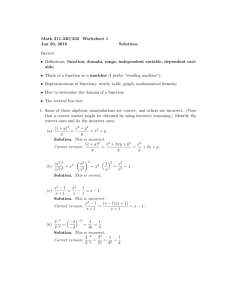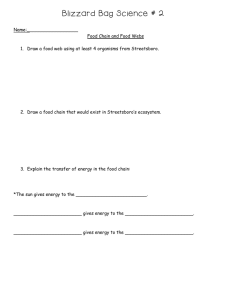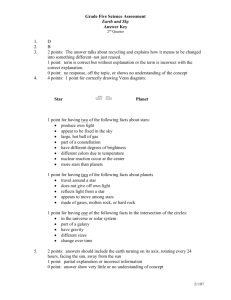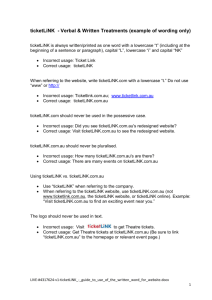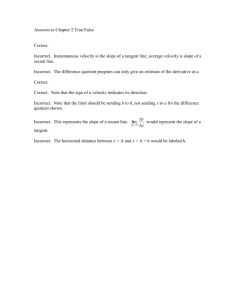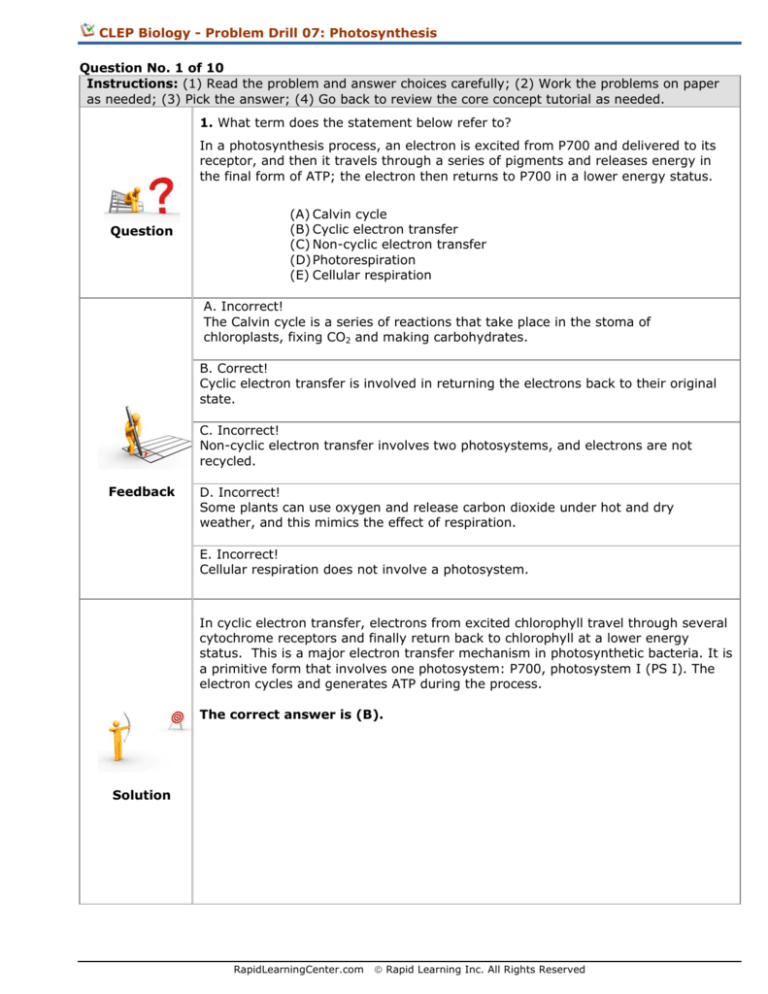
CLEP Biology - Problem Drill 07: Photosynthesis
Question No. 1 of 10
Instructions: (1) Read the problem and answer choices carefully; (2) Work the problems on paper
as needed; (3) Pick the answer; (4) Go back to review the core concept tutorial as needed.
1. What term does the statement below refer to?
In a photosynthesis process, an electron is excited from P700 and delivered to its
receptor, and then it travels through a series of pigments and releases energy in
the final form of ATP; the electron then returns to P700 in a lower energy status.
Question
(A) Calvin cycle
(B) Cyclic electron transfer
(C) Non-cyclic electron transfer
(D) Photorespiration
(E) Cellular respiration
A. Incorrect!
The Calvin cycle is a series of reactions that take place in the stoma of
chloroplasts, fixing CO2 and making carbohydrates.
B. Correct!
Cyclic electron transfer is involved in returning the electrons back to their original
state.
C. Incorrect!
Non-cyclic electron transfer involves two photosystems, and electrons are not
recycled.
Feedback
D. Incorrect!
Some plants can use oxygen and release carbon dioxide under hot and dry
weather, and this mimics the effect of respiration.
E. Incorrect!
Cellular respiration does not involve a photosystem.
In cyclic electron transfer, electrons from excited chlorophyll travel through several
cytochrome receptors and finally return back to chlorophyll at a lower energy
status. This is a major electron transfer mechanism in photosynthetic bacteria. It is
a primitive form that involves one photosystem: P700, photosystem I (PS I). The
electron cycles and generates ATP during the process.
The correct answer is (B).
Solution
RapidLearningCenter.com
© Rapid Learning Inc. All Rights Reserved
Question No. 2 of 10
Instructions: (1) Read the problem and answer choices carefully; (2) Work the problems on paper
as needed; (3) Pick the answer; (4) Go back to review the core concept tutorial as needed.
2. Which of the following statements only applies to C4 plants?
Question
(A) Chlorophyll is excited by photons.
(B) 3GPA is reduced and energized to produce high-energy G3P.
(C) Carbon dioxide is shuttled from one cell type to another.
(D) Protons are pumped into the thylakoid compartment from stroma.
(E) C4 plants do not use the sunlight.
A. Incorrect!
Chlorophyll is needed to excite the photons in all plants.
B. Incorrect!
3PGA is used to make G3P in all plants.
C. Correct!
Carbon dioxide is fixed and shuttled between mesophyl cells and bundle sheath
cells.
Feedback
D. Incorrect!
Protons are pumped into the thylakoid compartment in all types of plants.
E. Incorrect!
Both C4 and C3 plants use sunlight.
The C4 pathway is an adaptation to conserve the carbon dioxide released via
photorespiration. CO2 incorporated forms oxaloacetate (4C). This pathway is found
in mesophyll cells, which captures CO2 and delivers it to bundle sheath cells. The
bundle sheath cells take the CO2 for the Calvin cycle.
The correct answer is (C).
Solution
RapidLearningCenter.com
© Rapid Learning Inc. All Rights Reserved
Question No. 3 of 10
Instructions: (1) Read the problem and answer choices carefully; (2) Work the problems on paper
as needed; (3) Pick the answer; (4) Go back to review the core concept tutorial as needed.
3. Which of the following reactions does not occur during the dark reaction of
photosynthesis?
Question
(A) Utilization of NADPH
(B) Utilization of ATP
(C) Water is split into O2 and protons
(D) G3P production
(E) Utilization of CO2
A. Incorrect!
NADPH is used to change 3PGA to G3P.
B. Incorrect!
ATP is used to change 3PGA to G3P.
C. Correct!
Water is utilized in the light reaction and not the dark reaction.
Feedback
D. Incorrect!
3PGA is made into G3P.
E. Incorrect!
In the first step, carbon dioxide is fixed into 3PGA.
There are 3 phases in the Calvin Cycle:
Phase 1: Carbon Fixation, in which CO2 is incorporated into a five-carbon sugar,
called ribulose bisphosphate (RuBP).
Phase 2: Reduction, in which ATP and NADPH2 from the light reactions are used to
convert 3-phosphoglycerate to glyceraldehyde 3-phosphate, precursors of glucose.
Phase 3: Regeneration, in which more ATP is used to convert some of the G3P back
to RuBP the acceptor for CO2. This completes the cycle.
The correct answer is (C).
Solution
RapidLearningCenter.com
© Rapid Learning Inc. All Rights Reserved
Question No. 4 of 10
Instructions: (1) Read the problem and answer choices carefully; (2) Work the problems on paper
as needed; (3) Pick the answer; (4) Go back to review the core concept tutorial as needed.
4. The direct energy for generating ATP in the light reaction is _______.
Question
(A) The absorption of photons by chlorophyll.
(B) Oxidation of NADPH.
(C) Electron transfer between PS II and PS I.
(D) Proton gradient across the thylakoid membranes, generated by electron
transfer.
(E) Oxidation of water.
A. Incorrect!
The absorption of photons does not directly provide the energy for ATP synthesis.
B. Incorrect!
The oxidation of NADPH is used in the dark reaction of photosynthesis.
C. Incorrect!
The transfer of electrons helps to generate a proton gradient.
Feedback
D. Correct!
The proton gradient generated by the oxidation of compounds is directly
responsible for ATP synthesis.
E. Incorrect!
Oxidation of water is needed to help replenish electrons.
PSII absorbs light. An electron is excited to a higher energy level, which is then
transmitted through a light-harvesting complex (LHCII) until it reaches PSI. The
electron is captured by the primary electron acceptor. The water will be oxidized to
replace the electron.
The correct answer is (D).
Solution
RapidLearningCenter.com
© Rapid Learning Inc. All Rights Reserved
Question No. 5 of 10
Instructions: (1) Read the problem and answer choices carefully; (2) Work the problems on paper
as needed; (3) Pick the answer; (4) Go back to review the core concept tutorial as needed.
5. Which of the following statements is true about photorespiration?
Question
(A) Oxygen is consumed
(B) ATP is utilized
(C) No CO2 fixation
(D) No G3P production
(E) All of the above
A. Incorrect!
Oxygen is consumed during photorespiration. However, it is not the only true
statement here.
B. Incorrect!
ATP is utilized during photorespiration. However, it is not the only true statement
here.
C. Incorrect!
Carbon dioxide is not fixed during photorespiration. However, it is not the only true
statement here.
Feedback
D. Incorrect!
G3P is not produced during photorespiration. However, it is not the only true
statement here.
E. Correct!
All of these are consequences of photorespiration.
In the presence of low CO2 and high O2, Rubisco activity is switched into fixing O2,
generating no G3P (no energy). It takes in O2 and releases CO2. This is similar to
respiration and, therefore, it is called photorespiration.
The correct answer is (E).
Solution
RapidLearningCenter.com
© Rapid Learning Inc. All Rights Reserved
Question No. 6 of 10
Instructions: (1) Read the problem and answer choices carefully; (2) Work the problems on paper
as needed; (3) Pick the answer; (4) Go back to review the core concept tutorial as needed.
6. What is a network of chlorophyll and other pigments arranged together that
captures photons of energy and amplifies them?
Question
(A) Grana
(B) Thylakoid
(C) Stroma
(D) Photosystem
(E) Reaction center
A. Incorrect!
Grana are thylakoids arranged in stacks.
B. Incorrect!
The thylakoid is a phospholipid bilayer membrane-bound compartment internal to
chloroplasts where light reaction occurs.
C. Incorrect!
Stroma is the fluid surrounding the thylakoids’ site of dark reaction.
Feedback
D. Correct!
A photosystem is a network of chlorophyll pigments that captures photons.
E. Incorrect!
The reaction center is part of the photosystem.
There are two types of photosystems.
Photosystem I:
Contains P700, a chlorophyll molecule, which has peak absorption at 700 nm, the
reaction center of chlorophyll a.
A primitive form and the only type for photosynthetic bacteria.
Uses iron-sulfur (Fe-S) cluster proteins as its terminal electron receptor
Photosystem II:
Combines with PS I in plants to make the photosynthetic more effective.
Contains P680, responsible for water splitting – generating oxygen and proton.
Uses quinone as its terminal electron receptor.
Solution
The correct answer is (D).
RapidLearningCenter.com
© Rapid Learning Inc. All Rights Reserved
Question No. 7 of 10
Instructions: (1) Read the problem and answer choices carefully; (2) Work the problems on paper
as needed; (3) Pick the answer; (4) Go back to review the core concept tutorial as needed.
7. The equation of photosynthesis takes carbon dioxide, water and energy from
the sunlight and generates glucose and what?
Question
(A) Water
(B) Oxygen
(C) NADH
(D) A & B
(E) All of the above
A. Incorrect!
Water is a reactant and not a product.
B. Correct!
Oxygen is generated during photosynthesis.
C. Incorrect!
NADH is not generated during photosynthesis.
Feedback
D. Incorrect!
Although oxygen is generated, water is not, so this cannot be the correct answer.
E. Incorrect!
Only one of the answers above is the correct answer.
The correct equation for photosynthesis is:
6 CO2(gas) + 12 H2O(liquid) + photons → C6H12O6(aqueus) + 6 O2(gas) +
6H2O(liquid).
The correct answer is (B).
Solution
RapidLearningCenter.com
© Rapid Learning Inc. All Rights Reserved
Question No. 8 of 10
Instructions: (1) Read the problem and answer choices carefully; (2) Work the problems on paper
as needed; (3) Pick the answer; (4) Go back to review the core concept tutorial as needed.
8. Which of the following statement is incorrect?
Question
(A) In phase 1 of the Calvin cycle, carbon dioxide is incorporated into
RuBP.
(B) In phase 2 of the Calvin cycle, ATP and NADH are used.
(C) In phase 2 of the Calvin cycle, 3-PGA is converted into G3P.
(D) In phase 3 of the Calvin cycle, some of the G3P is converted back
into RuBP.
(E) All of these statements are correct.
A. Incorrect!
The statement is correct, but it is not the only correct statement about the dark
reaction.
B. Incorrect!
The statement is correct, but it is not the only correct statement about the dark
reaction.
C. Incorrect!
The statement is correct, but it is not the only correct statement about the dark
reaction.
Feedback
D. Incorrect!
The statement is correct, but it is not the only correct statement about the dark
reaction.
E. Correct!
Of the choices listed above, all of them are correct.
There are 3 phases in the Calvin Cycle:
Phase 1: Carbon Fixation, in which CO2 is incorporated into a five-carbon sugar,
called ribulose bisphosphate (RuBP).
Phase 2: Reduction, in which ATP and NADPH2 from the light reactions are used to
convert 3-phosphoglycerate to glyceraldehyde 3-phosphate, precursors of glucose.
Phase 3: Regeneration, in which more ATP is used to convert some of the G3P back
to RuBP the acceptor for CO2. This completes the cycle.
Solution
The correct answer is (E).
RapidLearningCenter.com
© Rapid Learning Inc. All Rights Reserved
Question No. 9 of 10
Instructions: (1) Read the problem and answer choices carefully; (2) Work the problems on paper
as needed; (3) Pick the answer; (4) Go back to review the core concept tutorial as needed.
9. Which of the following statements is correct?
Question
(A) PS I contains a chlorophyll pigment that best absorbs light at
680nm.
(B) The final electron acceptor for PS II is an iron-sulfur cluster
protein.
(C) The final electron acceptor for PS I is a quinine.
(D) PS II contains a chlorophyll pigment that best absorbs light at
700nm.
(E) None of these statements are correct.
A. Incorrect!
PS I best absorbs at 700nm.
B. Incorrect!
The final electron acceptor for PS II is a quinine.
C. Incorrect!
The final electron acceptor for PS I is an iron-sulfur cluster protein.
Feedback
D. Incorrect!
PSII best absorbs at 680nm.
E. Correct!
All of these statements are incorrect.
Photosystem I:
Contains P700, a chlorophyll molecule, which has peak absorption at 700 nm, the
reaction center chlorophyll a.
A primitive form and the only type for photosynthetic bacteria.
Uses iron-sulfur (Fe-S) cluster proteins as its terminal electron receptor
Photosystem II:
Combines with PS I in plants to make the photosynthetic more effective.
Contains P680, responsible for water splitting – generating oxygen and proton
Uses quinone as its terminal electron receptor.
The correct answer is (E).
Solution
RapidLearningCenter.com
© Rapid Learning Inc. All Rights Reserved
Question No. 10 of 10
Instructions: (1) Read the problem and answer choices carefully; (2) Work the problems on paper
as needed; (3) Pick the answer; (4) Go back to review the core concept tutorial as needed.
10. What is the process that plants can perform in the presence of low CO2, in
which they take in O2 and release CO2?
Question
(A) Photophosphorylation
(B) Cellular respiration
(C) Light reaction
(D) Dark reaction
(E) Photorespiration
A. Incorrect!
Photophosphorylation is the process of making ATP using the energy from the sun
to generate electrons for the electron transport chain.
B. Incorrect!
Cellular respiration takes in oxygen and releases carbon dioxide as a byproduct of
ATP production.
C. Incorrect!
The light reaction does not use carbon dioxide and does not take in oxygen.
Feedback
D. Incorrect!
The dark reaction does not release carbon dioxide.
E. Correct!
Photorespiration is the process where plants take in oxygen and release carbon
dioxide.
In the presence of low CO2 and high O2, Rubisco activity is switched into fixing O2,
generating no G3P (no energy). It takes in O2 and releases CO2, similar to
respiration and, therefore, it is called photorespiration.
The correct answer is (E).
Solution
RapidLearningCenter.com
© Rapid Learning Inc. All Rights Reserved


